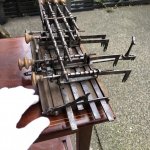Romak
Aluminum
- Joined
- Nov 2, 2011
- Location
- Surrey, BC
Someone said it's from the 1700s, doesn't mean it is. The provenance goes back about 70 years at this point. 70 is well shy of 222.
And what are those features?
Pictures of said features/forging/elements or documentation, please.
This tool is from the 1700s. It was confirmed by a family member and a museum it was taken to for identification. The decorative features could be seen on the stopper, the base, and the clamps.







 Spider plants all around the bedroom, waterbed, satin sheets, what more could you ask for
Spider plants all around the bedroom, waterbed, satin sheets, what more could you ask for 